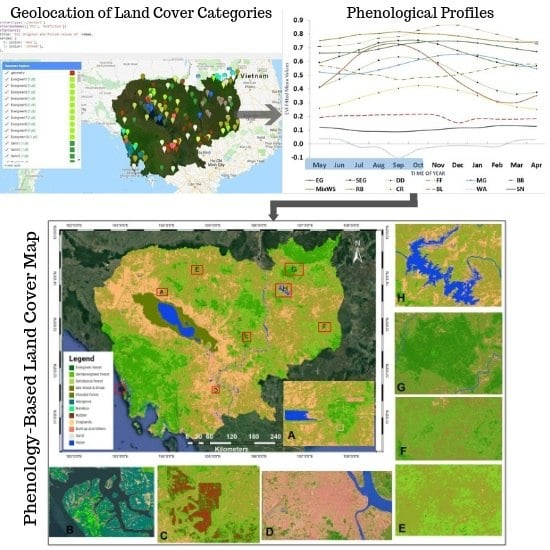Determination of Vegetation Thresholds for Assessing Land Use and Land Use Changes in Cambodia using the Google Earth Engine Cloud-Computing Platform
Abstract
1. Introduction
2. Materials and Methods
2.1. Study Area
2.2. Collection of Landsat Data and Image Composite
2.3. Reference Data
2.4. Land Surface Phenology Approach
- Landsat TM TOA and Landsat OLI TOA data were collected from the GEE. The underwent preprocessing and the time series of the collections were filtered. The image filter function and the composite, and reducer functions were applied to determine the median values within the study region. The EVI function was used to determine the phases of the composite median imagery.
- The data were smoothed and the geometry was plotted on reference land cover data to form temporal EVI profiles. The harmonic model function was used to compute the linear regression reducer, and the coefficients were plugged into the linear model to get the phase and amplitude.
- For phenology estimation, the average and mean EVI profiles of pixels of corresponding land cover types were calculated, and a search process was used to determine the phenology parameters, e.g., high-peak values and low values in time were identified through LSP and LFP as well as SOS and EOS. The threshold values for individual land cover categories were determined at specific phenology phases.
- To develop the mapping function for single EVI data, the GEE image reducer and median function were used to form composite time series images to give a single median EVI. The PBTC function was applied for median EVI classification. Eventually, the resulting threshold maps were validated using a VHR Geographic Information System (ArcGIS) image and reference forest cover data.
2.5. Selection of Land Cover Categories for the Phenology Assessment
2.6. Land Cover Category Phenology and Validation
2.7. Phenology-Based Threshold Classification Approach
2.8. Accuracy Assessment
3. Results
3.1. Phenological Behaviors of Land Cover Categories from Multi-Temporal Landsat Imagery
3.2. Mid-Dry Phenology and Threshold Mapping
3.3. Phenology-Based Threshold Map and Accuracy Assessment
4. Discussions and Implications
5. Conclusions
Author Contributions
Funding
Acknowledgments
Conflicts of Interest
Appendix A
| L 5 TM TOA | L 7 ETM TOA | L 8 OIL TOA | |||||||
|---|---|---|---|---|---|---|---|---|---|
| PATH | RAW | 2000 | 2001 | 2002 | 2003 | 2014 | 2015 | 2016 | 2017 |
| 124 | 50 | 15 | 15 | 11 | 13 | 19 | 21 | 21 | 17 |
| 51 | 10 | 13 | 10 | 14 | 19 | 21 | 19 | 18 | |
| 52 | 14 | 11 | 9 | 15 | 22 | 20 | 19 | 21 | |
| 125 | 50 | 12 | 9 | 15 | 12 | 17 | 20 | 19 | 15 |
| 51 | 11 | 10 | 13 | 12 | 14 | 16 | 13 | 12 | |
| 52 | 14 | 12 | 13 | 12 | 19 | 21 | 18 | 18 | |
| 53 | 16 | 12 | 12 | 14 | 19 | 17 | 19 | 18 | |
| 126 | 50 | 14 | 9 | 14 | 15 | 17 | 16 | 16 | 15 |
| 51 | 14 | 10 | 16 | 12 | 21 | 20 | 18 | 16 | |
| 52 | 20 | 11 | 14 | 13 | 23 | 20 | 20 | 18 | |
| 53 | 16 | 10 | 12 | 13 | 21 | 19 | 19 | 18 | |
| 127 | 50 | 16 | 10 | 11 | 13 | 20 | 20 | 19 | 18 |
| 51 | 14 | 10 | 9 | 11 | 17 | 22 | 22 | 20 | |
| 52 | 17 | 10 | 10 | 12 | 17 | 21 | 21 | 17 | |
| 53 | 13 | 10 | 10 | 13 | 16 | 18 | 20 | 18 | |
| 128 | 50 | 19 | 12 | 10 | 12 | 19 | 19 | 20 | 17 |
| 51 | 18 | 12 | 11 | 10 | 20 | 20 | 18 | 19 | |
| 52 | 3 | 2 | 6 | 6 | 13 | 19 | 11 | 17 | |
| Total Collections | 256 | 188 | 206 | 222 | 333 | 350 | 332 | 312 | |
| Observations (%) | 11.64% | 8.55% | 9.37% | 10.10% | 15.14% | 15.92% | 15.10% | 14.19% | |
| Landsat OLI | TM | ||||
|---|---|---|---|---|---|
| Land Cover Categories | Min | Max | Min | Max | Suitable Months |
| BB | 0.854 | 0.882 | 0.6712 | 0.776 | Dec-Feb |
| RB | 0.815 | 0.841 | 0.6595 | 0. 6613 | Dec-Feb |
| EG | 0.652 | 0.769 | 0.515 | 0.659 | Dec-Feb |
| SE | 0.581 | 0.648 | 0.435 | 0.501 | Dec-Feb |
| DD | 0.476 | 0.556 | 0.301 | 0.421 | Dec-Feb |
| Mix WS | 0.385 | 0.445 | 0.212 | 0.275 | Dec-Feb |
| CR | 0.21 | 0.38 | 0.11 | 0.159 | Dec-Feb |
| BL | 0.056 | 0.209 | 0.019 | 0.105 | All year |
| SN | 0.01 | 0.015 | 0.005 | 0.012 | All year |
| WA | −0.13 | 0.009 | −0.13 | 0.009 | All year |
| FF | 0.382 | 0.581 | 0.381 | 0.519 | Dec-Feb |
| MG | 0.402 | 0.654 | 0.384 | 0.532 | Dec-Feb |
References
- Sandker, M.; Suwarno, A.; Campbell, B.M. Will Forests Remain in the Face of Oil Palm Expansion? Simulating Change in Malinau, Indonesia. Ecol. Soc. 2007, 12. [Google Scholar] [CrossRef]
- Sasaki, N.; Asner, G.P.; Pan, Y.; Knorr, W.; Durst, P.B.; Ma, H.O.; Abe, I.; Lowe, A.J.; Koh, L.P.; Putz, F.E. Sustainable Management of Tropical Forests Can Reduce Carbon Emissions and Stabilize Timber Production. Front. Environ. Sci. 2016, 4, 50. [Google Scholar] [CrossRef]
- Coppin, P.; Jonckheere, I.; Nackaerts, K.; Muys, B.; Lambin, E. Review ArticleDigital change detection methods in ecosystem monitoring: A review. Int. J. Remote Sens. 2004, 25, 1565–1596. [Google Scholar] [CrossRef]
- Lunetta, R.S.; Johnson, D.M.; Lyon, J.G.; Crotwell, J. Impacts of imagery temporal frequency on land-cover change detection monitoring. Remote Sens. Environ. 2004, 89, 444–454. [Google Scholar] [CrossRef]
- Hansen, M.C.; Potapov, P.V.; Moore, R.; Hancher, M.; Turubanova, S.A.; Tyukavina, A.; Thau, D.; Stehman, S.V.; Goetz, S.J.; Loveland, T.R.; et al. High-Resolution Global Maps of 21st-Century Forest Cover Change. Science 2013, 342, 850–853. [Google Scholar] [CrossRef] [PubMed]
- Chuine, I.; Cour, P.; Rousseau, D.D. Selecting models to predict the timing of flowering of temperate trees: Implications for tree phenology modelling. Plant Cell Environ. 1999, 22, 1–13. [Google Scholar] [CrossRef]
- Tucker, C.J.; Pinzon, J.E.; Brown, M.E.; Slayback, D.A.; Pak, E.W.; Mahoney, R.; Vermote, E.F.; El Saleous, N. An extended AVHRR 8-km NDVI dataset compatible with MODIS and SPOT vegetation NDVI data. Int. J. Remote Sens. 2005, 26, 4485–4498. [Google Scholar] [CrossRef]
- Pohl, C.; Van Genderen, J.L. Review article Multisensor image fusion in remote sensing: Concepts, methods and applications. Int. J. Remote Sens. 1998, 19, 823–854. [Google Scholar] [CrossRef]
- Mas, J.-F. Monitoring land-cover changes: A comparison of change detection techniques. Int. J. Remote Sens. 1999, 20, 139–152. [Google Scholar] [CrossRef]
- Chen, G.; Hay, G.J.; Carvalho, L.M.T.; Wulder, M.A. Object-based change detection. Int. J. Remote Sens. 2012, 33, 4434–4457. [Google Scholar] [CrossRef]
- Lu, D.; Weng, Q. A survey of image classification methods and techniques for improving classification performance. Int. J. Remote Sens. 2007, 28, 823–870. [Google Scholar] [CrossRef]
- Romijn, E.; Lantican, C.B.; Herold, M.; Lindquist, E.; Ochieng, R.; Wijaya, A.; Murdiyarso, D.; Verchot, L. Assessing change in national forest monitoring capacities of 99 tropical countries. For. Ecol. Manag. 2015, 352, 109–123. [Google Scholar] [CrossRef]
- Pengra, B.; Long, J.; Dahal, D.; Stehman, S.V.; Loveland, T.R. A global reference database from very high resolution commercial satellite data and methodology for application to Landsat derived 30m continuous field tree cover data. Remote Sens. Environ. 2015, 165, 234–248. [Google Scholar] [CrossRef]
- Bey, A.; Díaz, A.S.P.; Maniatis, D.; Marchi, G.; Mollicone, D.; Ricci, S.; Bastin, J.F.; Moore, R.; Federici, S.; Rezende, M.; et al. Collect earth: Land use and land cover assessment through augmented visual interpretation. Remote Sens. 2016, 8, 807. [Google Scholar] [CrossRef]
- GEE Google Earth Engine. Available online: https://earthengine.google.com/ (accessed on 16 November 2018).
- Wang, Y.; Ziv, G.; Adami, M.; Mitchard, E.; Batterman, S.A.; Buermann, W.; Schwantes Marimon, B.; Hur, B.; Junior, M.; Reis, S.M.; et al. Mapping tropical disturbed forests using multi-decadal 30 m optical satellite imagery. Remote Sens. Environ. 2019, 21, 474–488. [Google Scholar] [CrossRef]
- Nyland, K.E.; Gunn, G.E.; Shiklomanov, N.I.; Engstrom, R.N.; Streletskiy, D.A. Land cover change in the lower Yenisei River using dense stacking of landsat imagery in Google Earth Engine. Remote Sens. 2018, 10, 1226. [Google Scholar] [CrossRef]
- Kumar, L.; Mutanga, O. Google Earth Engine Applications Since Inception: Usage, Trends, and Potential. Remote Sens. 2018, 10, 1509. [Google Scholar] [CrossRef]
- Gorelick, N.; Hancher, M.; Dixon, M.; Ilyushchenko, S.; Thau, D.; Moore, R. Google Earth Engine: Planetary-scale geospatial analysis for everyone. Remote Sens. Environ. 2017, 202, 18–27. [Google Scholar] [CrossRef]
- GEE Earth Engine Data Catalog|Google Developers. Available online: https://developers.google.com/earth-engine/datasets/ (accessed on 15 October 2018).
- Shelestov, A.; Lavreniuk, M.; Kussul, N.; Novikov, A.; Skakun, S. Large scale crop classification using Google earth engine platform. In Proceedings of the 2017 IEEE International Geoscience and Remote Sensing Symposium (IGARSS), Fort Worth, TX, USA, 23–28 July 2017; pp. 3696–3699. [Google Scholar]
- Langner, A.; Miettinen, J.; Kukkonen, M.; Vancutsem, C.; Simonetti, D.; Vieilledent, G.; Verhegghen, A.; Gallego, J.; Stibig, H.J. Towards operational monitoring of forest canopy disturbance in evergreen rain forests: A test case in continental Southeast Asia. Remote Sens. 2018, 10, 544. [Google Scholar] [CrossRef]
- Tsai, Y.H.; Stow, D.; Chen, H.L.; Lewison, R.; An, L.; Shi, L. Mapping vegetation and land use types in Fanjingshan National Nature Reserve using google earth engine. Remote Sens. 2018, 10, 927. [Google Scholar] [CrossRef]
- Parente, L.; Ferreira, L. Assessing the spatial and occupation dynamics of the Brazilian pasturelands based on the automated classification of MODIS images from 2000 to 2016. Remote Sens. 2018, 10, 606. [Google Scholar] [CrossRef]
- Huang, H.; Chen, Y.; Clinton, N.; Wang, J.; Wang, X.; Liu, C.; Gong, P.; Yang, J.; Bai, Y.; Zheng, Y.; et al. Mapping major land cover dynamics in Beijing using all Landsat images in Google Earth Engine. Remote Sens. Environ. 2017, 202, 166–176. [Google Scholar] [CrossRef]
- Sidhu, N.; Pebesma, E.; Câmara, G. Using Google Earth Engine to detect land cover change: Singapore as a use case. Eur. J. Remote Sens. 2018, 51, 486–500. [Google Scholar] [CrossRef]
- Adole, T.; Dash, J.; Atkinson, P.M. Characterising the land surface phenology of Africa using 500 m MODIS EVI. Appl. Geogr. 2018, 90, 187–199. [Google Scholar] [CrossRef]
- Tang, J.; Körner, C.; Muraoka, H.; Piao, S.; Shen, M.; Thackeray, S.J.; Yang, X. Emerging opportunities and challenges in phenology: A review. Ecosphere 2016, 7, e01436. [Google Scholar] [CrossRef]
- Knight, J.F.; Lunetta, R.S.; Ediriwickrema, J.; Khorram, S. Regional Scale Land Cover Characterization Using MODIS-NDVI 250 m Multi-Temporal Imagery: A Phenology-Based Approach. GIScience Remote Sens. 2006, 43, 1–23. [Google Scholar] [CrossRef]
- USGS Remote Sensing Phenology. Available online: https://phenology.cr.usgs.gov/ (accessed on 17 November 2018).
- Yan, E.; Wang, G.; Lin, H.; Xia, C.; Sun, H. Phenology-based classification of vegetation cover types in Northeast China using MODIS NDVI and EVI time series. Int. J. Remote Sens. 2015, 36, 489–512. [Google Scholar] [CrossRef]
- Chmielewski, F.-M.; Rötzer, T. Response of tree phenology to climate change across Europe. Agric. For. Meteorol. 2001, 108, 101–112. [Google Scholar] [CrossRef]
- Fitter, A.H.; Fitter, R.S.R.; Harris, I.T.B.; Williamson, M.H. Relationships Between First Flowering Date and Temperature in the Flora of a Locality in Central England. Funct. Ecol. 2006, 9, 55. [Google Scholar] [CrossRef]
- Zhou, L.; Tucker, C.J.; Kaufmann, R.K.; Slayback, D.; Shabanov, N.V.; Myneni, R.B. Variations in northern vegetation activity inferred from satellite data of vegetation index during 1981 to 1999. J. Geophys. Res. Atmos. 2001, 106, 20069–20083. [Google Scholar] [CrossRef]
- Maignan, F.; Bréon, F.-M.; Bacour, C.; Demarty, J.; Poirson, A. Interannual vegetation phenology estimates from global AVHRR measurements. Remote Sens. Environ. 2008, 112, 496–505. [Google Scholar] [CrossRef]
- Clinton, N.; Yu, L.; Fu, H.; He, C.; Gong, P. Global-Scale Associations of Vegetation Phenology with Rainfall and Temperature at a High Spatio-Temporal Resolution. Remote Sens. 2014, 6, 7320–7338. [Google Scholar] [CrossRef]
- Li, P.; Jiang, L.; Feng, Z.; Li, P.; Jiang, L.; Feng, Z. Cross-Comparison of Vegetation Indices Derived from Landsat-7 Enhanced Thematic Mapper Plus (ETM+) and Landsat-8 Operational Land Imager (OLI) Sensors. Remote Sens. 2013, 6, 310–329. [Google Scholar] [CrossRef]
- Adams, J. Classification of multispectral images based on fractions of endmembers: Application to land-cover change in the Brazilian Amazon. Remote Sens. Environ. 1995, 52, 137–154. [Google Scholar] [CrossRef]
- Alwashe, M.A.; Bokhari, A.Y. Monitoring vegetation changes in Al Madinah, Saudi Arabia, using Thematic Mapper data. Int. J. Remote Sens. 1993, 14, 191–197. [Google Scholar] [CrossRef]
- Andres, L.; Salas, W.A.; Skole, D. Fourier analysis of multi-temporal AVHRR data applied to a land cover classification. Int. J. Remote Sens. 1994, 15, 1115–1121. [Google Scholar] [CrossRef]
- Beck, P.S.A.; Goetz, S.J. Satellite observations of high northern latitude vegetation productivity changes between 1982 and 2008: Ecological variability and regional differences. Environ. Res. Lett. 2011, 6, 045501. [Google Scholar] [CrossRef]
- Boelman, N.T.; Gough, L.; McLaren, J.R.; Greaves, H. Does NDVI reflect variation in the structural attributes associated with increasing shrub dominance in arctic tundra? Environ. Res. Lett. 2011, 6, 035501. [Google Scholar] [CrossRef]
- Richardson, A.D.; Hufkens, K.; Milliman, T.; Aubrecht, D.M.; Chen, M.; Gray, J.M.; Johnston, M.R.; Keenan, T.F.; Klosterman, S.T.; Kosmala, M.; et al. Tracking vegetation phenology across diverse North American biomes using PhenoCam imagery. Sci. Data 2018, 5, 180028. [Google Scholar] [CrossRef]
- Amalisana, B.; Rokhmatullah; Hernina, R. Land Cover Analysis by Using Pixel-Based and Object-Based Image Classification Method in Bogor. IOP Conf. Ser. Earth Environ. Sci. 2017, 98, 012005. [Google Scholar] [CrossRef]
- White, M.A.; de Beurs, K.M.; Didan, K.; Inouye, D.W.; Richardson, A.D.; Jensen, O.P.; O’Keefe, J.; Zhang, G.; Nemani, R.R.; van Leeuwen, W.J.D.; et al. Intercomparison, interpretation, and assessment of spring phenology in North America estimated from remote sensing for 1982-2006. Glob. Chang. Biol. 2009, 15, 2335–2359. [Google Scholar] [CrossRef]
- Chang, J.; Hansen, M.C.; Pittman, K.; Carroll, M.; DiMiceli, C. Corn and Soybean Mapping in the United States Using MODIS Time-Series Data Sets. Agron. J. 2007, 99, 1654. [Google Scholar] [CrossRef]
- Brooks, E.B.; Thomas, V.A.; Wynne, R.H.; Coulston, J.W. Fitting the multitemporal curve: A fourier series approach to the missing data problem in remote sensing analysis. IEEE Trans. Geosci. Remote Sens. 2012, 50, 3340–3353. [Google Scholar] [CrossRef]
- Carrao, H.; Gonalves, P.; Caetano, M. A Nonlinear Harmonic Model for Fitting Satellite Image Time Series: Analysis and Prediction of Land Cover Dynamics. IEEE Trans. Geosci. Remote Sens. 2010, 48, 1919–1930. [Google Scholar] [CrossRef]
- Chen, B.; Huang, B.; Chen, L.; Xu, B. Spatially and Temporally Weighted Regression: A Novel Method to Produce Continuous Cloud-Free Landsat Imagery. IEEE Trans. Geosci. Remote Sens. 2017, 55, 27–37. [Google Scholar] [CrossRef]
- Wilson, B.T.; Knight, J.F.; McRoberts, R.E. Harmonic regression of Landsat time series for modeling attributes from national forest inventory data. ISPRS J. Photogramm. Remote Sens. 2018, 137, 29–46. [Google Scholar] [CrossRef]
- Roy, D.P.; Yan, L. Robust Landsat-based crop time series modelling. Remote Sens. Environ. 2018. [Google Scholar] [CrossRef]
- Vogeler, J.C.; Braaten, J.D.; Slesak, R.A.; Falkowski, M.J. Extracting the full value of the Landsat archive: Inter-sensor harmonization for the mapping of Minnesota forest canopy cover (1973–2015). Remote Sens. Environ. 2018, 209, 363–374. [Google Scholar] [CrossRef]
- Simonetti, D.; Simonetti, E.; Szantoi, Z.; Lupi, A.; Eva, H.D. First Results from the Phenology-Based Synthesis Classifier Using Landsat 8 Imagery. IEEE Geosci. Remote Sens. Lett. 2015, 12, 1496–1500. [Google Scholar] [CrossRef]
- Simonetti, E.; Simonetti, D.; Preatoni, D. Phenology-Based Land cover Classification Using Landsat 8 Time Series; Report EUR 26841 EN; European Commission Joint Research Center: Ispra, Italy, 2014. [Google Scholar] [CrossRef]
- Zhang, M.; Lin, H. Object-based rice mapping using time-series and phenological data. Adv. Space Res. 2018, 63, 190–202. [Google Scholar] [CrossRef]
- Schwieder, M.; Leitão, P.J.; Pinto, J.R.R.; Teixeira, A.M.C.; Pedroni, F.; Sanchez, M.; Bustamante, M.M.; Hostert, P. Landsat phenological metrics and their relation to aboveground carbon in the Brazilian Savanna. Carbon Balance Manag. 2018, 13, 7. [Google Scholar] [CrossRef] [PubMed]
- Parks, S.A.; Holsinger, L.M.; Voss, M.A.; Loehman, R.A.; Robinson, N.P. Mean composite fire severity metrics computed with google earth engine offer improved accuracy and expanded mapping potential. Remote Sens. 2018, 10, 879. [Google Scholar] [CrossRef]
- Sazib, N.; Mladenova, I.; Bolten, J. Leveraging the google earth engine for drought assessment using global soil moisture data. Remote Sens. 2018, 10, 1265. [Google Scholar] [CrossRef]
- Campos-Taberner, M.; Moreno-Martínez, Á.; García-Haro, F.J.; Camps-Valls, G.; Robinson, N.P.; Kattge, J.; Running, S.W. Global estimation of biophysical variables from Google Earth Engine platform. Remote Sens. 2018, 10, 1167. [Google Scholar] [CrossRef]
- Markert, K.N.; Schmidt, C.M.; Griffin, R.E.; Flores, A.I.; Poortinga, A.; Saah, D.S.; Muench, R.E.; Clinton, N.E.; Chishtie, F.; Kityuttachai, K.; et al. Historical and operational monitoring of surface sediments in the Lower Mekong Basin using Landsat and Google Earth Engine cloud computing. Remote Sens. 2018, 10, 909. [Google Scholar] [CrossRef]
- Mateo-García, G.; Gómez-Chova, L.; Amorós-López, J.; Muñoz-Marí, J.; Camps-Valls, G. Multitemporal cloud masking in the Google Earth Engine. Remote Sens. 2018, 10, 1079. [Google Scholar] [CrossRef]
- Ito, E.; Araki, M.; Tani, A.; Kanzaki, M.; Saret, K.; Seila, D.; Phearak, P.; Sopheap, L.; Sopheavuth, P. Leaf-shedding phenology in tropical seasonal forests of Cambodia estimated from NOAA satellite images. In Proceedings of the 2007 IEEE International Geoscience and Remote Sensing Symposium, Barcelona, Spain, 23–28 July 2007; pp. 4331–4335. [Google Scholar] [CrossRef]
- Son, N.T.; Chen, C.F.; Chen, C.R.; Duc, H.N.; Chang, L.Y. A phenology-based classification of time-series MODIS data for rice crop monitoring in Mekong Delta, Vietnam. Remote Sens. 2013, 6, 135–156. [Google Scholar] [CrossRef]
- Fan, H.; Fu, X.; Zhang, Z.; Wu, Q.; Fan, H.; Fu, X.; Zhang, Z.; Wu, Q. Phenology-Based Vegetation Index Differencing for Mapping of Rubber Plantations Using Landsat OLI Data. Remote Sens. 2015, 7, 6041–6058. [Google Scholar] [CrossRef]
- Sasaki, N.; Chheng, K.; Mizoue, N.; Abe, I.; Lowe, A.J. Forest reference emission level and carbon sequestration in Cambodia. Glob. Ecol. Conserv. 2016, 7, 82–96. [Google Scholar] [CrossRef]
- Saint-Exupéry, A. de Pilot de guerra. Nov. Col·Lecció Lletres 1958, 36, 248. [Google Scholar] [CrossRef]
- Chheng, K.; Sasaki, N.; Mizoue, N.; Khorn, S.; Kao, D.; Lowe, A. Assessment of carbon stocks of semi-evergreen forests in Cambodia. Glob. Ecol. Conserv. 2016, 5, 34–47. [Google Scholar] [CrossRef]
- MoE Cambodia Evnvironment Outlook. Available online: https://wedocs.unep.org/bitstream/handle/20.500.11822/8689/Cambodia_environment_outlook.pdf?sequence=3&isAllowed=y (accessed on 19 November 2018).
- Peel, M.C.; Finlayson, B.L.; McMahon, T.A. Updated world map of the Köppen-Geiger climate classification. Hydrol. Earth Syst. Sci. 2007, 11, 1633–1644. [Google Scholar] [CrossRef]
- MoA Climate Change Priorities Action Plan for Agriculture, Forestry and Fisheries Sector 2016–2020. Available online: http://www.twgaw.org/wp-content/uploads/2016/08/MAFF-CCPAP-2016-2020_final_CLEAN.pdf (accessed on 19 November 2018).
- FAO GIEWS Global Information and Early Warning System on Food and Agriculture GIEWS Country Brief Cambodia. Available online: http://www.fao.org/giews/countrybrief/country.jsp?code=KHM (accessed on 20 November 2018).
- Sim, K.; Sou, S.; Sam, C.; Chou, P.; Neang, M. Impacts of Climate Change on Rice Production in Cambodia. Available online: https://www.researchgate.net/publication/264540118_The_Impact_of_Climate_Change_on_Rice_Production_in_Cambodia (accessed on 28 November 2018).
- FREL, C. Initial Forest Reference Level for Cambodia under the UNFCCC Framework. Available online: https://redd.unfccc.int/files/cambodia_frl_rcvd17112016.pdf (accessed on 17 November 2018).
- Cohen, W.B.; Yang, Z.; Kennedy, R. Detecting trends in forest disturbance and recovery using yearly Landsat time series: 2. TimeSync—Tools for calibration and validation. Remote Sens. Environ. 2010, 114, 2911–2924. [Google Scholar] [CrossRef]
- Gibbs, H.K.; Brown, S.; Niles, J.O.; Foley, J.A. Monitoring and estimating tropical forest carbon stocks: Making REDD a reality. Environ. Res. Lett. 2007, 2, 045023. [Google Scholar] [CrossRef]
- Kou, W.; Xiao, X.; Dong, J.; Gan, S.; Zhai, D.; Zhang, G.; Qin, Y.; Li, L. Mapping deciduous rubber plantation areas and stand ages with PALSAR and landsat images. Remote Sens. 2015, 7, 1048–1073. [Google Scholar] [CrossRef]
- Kou, W.; Liang, C.; Wei, L.; Hernandez, A.; Yang, X. Phenology-Based Method for Mapping Tropical Evergreen Forests by Integrating of MODIS and Landsat Imagery. Forests 2017, 8, 34. [Google Scholar] [CrossRef]
- Dong, J.; Xiao, X.; Menarguez, M.A.; Zhang, G.; Qin, Y.; Thau, D.; Biradar, C.; Moore, B. Mapping paddy rice planting area in northeastern Asia with Landsat 8 images, phenology-based algorithm and Google Earth Engine. Remote Sens. Environ. 2016, 185, 142–154. [Google Scholar] [CrossRef] [PubMed]
- Qiu, B.; Li, W.; Tang, Z.; Chen, C.; Qi, W. Mapping paddy rice areas based on vegetation phenology and surface moisture conditions. Ecol. Indic. 2015, 56, 79–86. [Google Scholar] [CrossRef]
- Zhou, Y.; Xiao, X.; Qin, Y.; Dong, J.; Zhang, G.; Kou, W.; Jin, C.; Wang, J.; Li, X. Mapping paddy rice planting area in rice-wetland coexistent areas through analysis of Landsat 8 OLI and MODIS images. Int. J. Appl. Earth Obs. Geoinf. 2016, 46, 1–12. [Google Scholar] [CrossRef] [PubMed]
- Huete, A.; Didan, K.; Miura, T.; Rodriguez, E.; Gao, X.; Ferreira, L. Overview of the radiometric and biophysical performance of the MODIS vegetation indices. Remote Sens. Environ. 2002, 83, 195–213. [Google Scholar] [CrossRef]
- Xu, Y.; Yu, L.; Zhao, F.R.; Cai, X.; Zhao, J.; Lu, H.; Gong, P. Tracking annual cropland changes from 1984 to 2016 using time-series Landsat images with a change-detection and post-classification approach: Experiments from three sites in Africa. Remote Sens. Environ. 2018, 218, 13–31. [Google Scholar] [CrossRef]
- Banskota, A.; Kayastha, N.; Falkowski, M.J.; Wulder, M.A.; Froese, R.E.; White, J.C. Forest Monitoring Using Landsat Time Series Data: A Review. Can. J. Remote Sens. 2014, 40, 362–384. [Google Scholar] [CrossRef]
- Xiong, J.; Thenkabail, P.S.; Tilton, J.C.; Gumma, M.K.; Teluguntla, P.; Oliphant, A.; Congalton, R.G.; Yadav, K.; Gorelick, N. Nominal 30-m cropland extent map of continental Africa by integrating pixel-based and object-based algorithms using Sentinel-2 and Landsat-8 data on google earth engine. Remote Sens. 2017, 9, 1065. [Google Scholar] [CrossRef]
- Moulin, S.; Kergoat, L.; Viovy, N.; Dedieu, G.; Moulin, S.; Kergoat, L.; Viovy, N.; Dedieu, G. Global-Scale Assessment of Vegetation Phenology Using NOAA/AVHRR Satellite Measurements. J. Clim. 1997, 10, 1154–1170. [Google Scholar] [CrossRef]
- Kontgis, C.; Schneider, A.; Ozdogan, M. Mapping rice paddy extent and intensification in the Vietnamese Mekong River Delta with dense time stacks of Landsat data. Remote Sens. Environ. 2015, 169, 255–269. [Google Scholar] [CrossRef]
- Wang, J.; Xiao, X.; Qin, Y.; Dong, J.; Zhang, G.; Kou, W.; Jin, C.; Zhou, Y.; Zhang, Y. Mapping paddy rice planting area in wheat-rice double-cropped areas through integration of Landsat-8 OLI, MODIS, and PALSAR images. Sci. Rep. 2015, 5. [Google Scholar] [CrossRef] [PubMed]
- Goldblatt, R. High Spatial Resolution Visual Band Imagery Outperforms Medium Resolution Spectral Imagery for Ecosystem Assessment in the Semi-Arid Brazilian Sertão. Remote Sens. 2017, 9, 1336. [Google Scholar] [CrossRef]
- Chander, G.; Markham, B.L.; Helder, D.L. Summary of current radiometric calibration coefficients for Landsat MSS, TM, ETM+, and EO-1 ALI sensors. Remote Sens. Environ. 2009, 113, 893–903. [Google Scholar] [CrossRef]
- Matsushita, B.; Yang, W.; Chen, J.; Onda, Y.; Qiu, G. Sensitivity of the Enhanced Vegetation Index (EVI) and Normalized Difference Vegetation Index (NDVI) to Topographic Effects: A Case Study in High-density Cypress Forest. Sensors 2007, 7, 2636–2651. [Google Scholar] [CrossRef]
- Samreth, V.; Chheng, K.; Monda, Y.; Kiyono, Y.; Toriyama, J.; Saito, S.; Saito, H.; Ito, E. Tree Biomass Carbon Stock Estimation using Permanent Sampling Plot Data in Different Types of Seasonal Forests in Cambodia. Jpn. Agric. Res. Q. 2012, 46, 187–192. [Google Scholar] [CrossRef][Green Version]
- Shumway, R.H.; Stoffer, D.S. Time Series Analysis and its Applications; Springer International Publishing: Cham, Switzerland, 2017. [Google Scholar]
- White, K.; Pontius, J.; Schaberg, P. Remote sensing of spring phenology in northeastern forests: A comparison of methods, field metrics and sources of uncertainty. Remote Sens. Environ. 2014, 148, 97–107. [Google Scholar] [CrossRef]
- Myneni, R.B.; Tømmervik, H.; Ganguly, S.; Karlsen, S.R.; Brovkin, V.; Park, T.; Høgda, K.-A.; Euskirchen, E.S.; Nemani, R.R. Changes in growing season duration and productivity of northern vegetation inferred from long-term remote sensing data. Environ. Res. Lett. 2016, 11, 084001. [Google Scholar] [CrossRef]
- Walther, S.; Voigt, M.; Thum, T.; Gonsamo, A.; Zhang, Y.; Köhler, P.; Jung, M.; Varlagin, A.; Guanter, L. Satellite chlorophyll fluorescence measurements reveal large-scale decoupling of photosynthesis and greenness dynamics in boreal evergreen forests. Glob. Chang. Biol. 2016, 22, 2979–2996. [Google Scholar] [CrossRef] [PubMed]
- D’Odorico, P.; Gonsamo, A.; Gough, C.M.; Bohrer, G.; Morison, J.; Wilkinson, M.; Hanson, P.J.; Gianelle, D.; Fuentes, J.D.; Buchmann, N. The match and mismatch between photosynthesis and land surface phenology of deciduous forests. Agric. For. Meteorol. 2015, 214–215, 25–38. [Google Scholar] [CrossRef]
- Olofsson, P.; Foody, G.M.; Herold, M.; Stehman, S.V.; Woodcock, C.E.; Wulder, M.A. Good practices for estimating area and assessing accuracy of land change. Remote Sens. Environ. 2014, 148, 42–57. [Google Scholar] [CrossRef]
- Ito, E.; Khorn, S.; Lim, S.; Pol, S.; Tith, B.; Pith, P.; Tani, A.; Kanzaki, M.; Kaneko, T.; Okuda, Y.; et al. Comparison of the leaf area index (LAI) of two types of dipterocarp forest on the west bank of the Mekong river, Cambodia. In Forest Environments in the Mekong River Basin; Springer: Tokyo, Japan, 2007; pp. 214–221. [Google Scholar]
- Ren, S.; Yi, S.; Peichl, M.; Wang, X. Diverse responses of vegetation phenology to climate change in different Grasslands in Inner Mongolia during 2000–2016. Remote Sens. 2018, 10, 17. [Google Scholar] [CrossRef]
- Tang, G.; Iii, J.A.A.; Verburg, P.S.J.; Jasoni, R.L.; Sun, L. Trends and climatic sensitivities of vegetation phenology in semiarid and arid ecosystems in the US Great Basin during 1982–2011. Biogeosciences 2015, 12, 6985–6997. [Google Scholar] [CrossRef]
- Helman, D. Land surface phenology: What do we really ‘see’ from space? Sci. Total Environ. 2018, 618, 665–673. [Google Scholar] [CrossRef]
- Funk, C.; Peterson, P.; Landsfeld, M.; Pedreros, D.; Verdin, J.; Shukla, S.; Husak, G.; Rowland, J.; Harrison, L.; Hoell, A.; et al. The climate hazards infrared precipitation with stations—A new environmental record for monitoring extremes. Sci. Data 2015, 2, 150066. [Google Scholar] [CrossRef]
- NASA MODIS Products Table | LP DAAC:: NASA Land Data Products and Services. Available online: https://lpdaac.usgs.gov/products/modis_products_table (accessed on 24 January 2019).
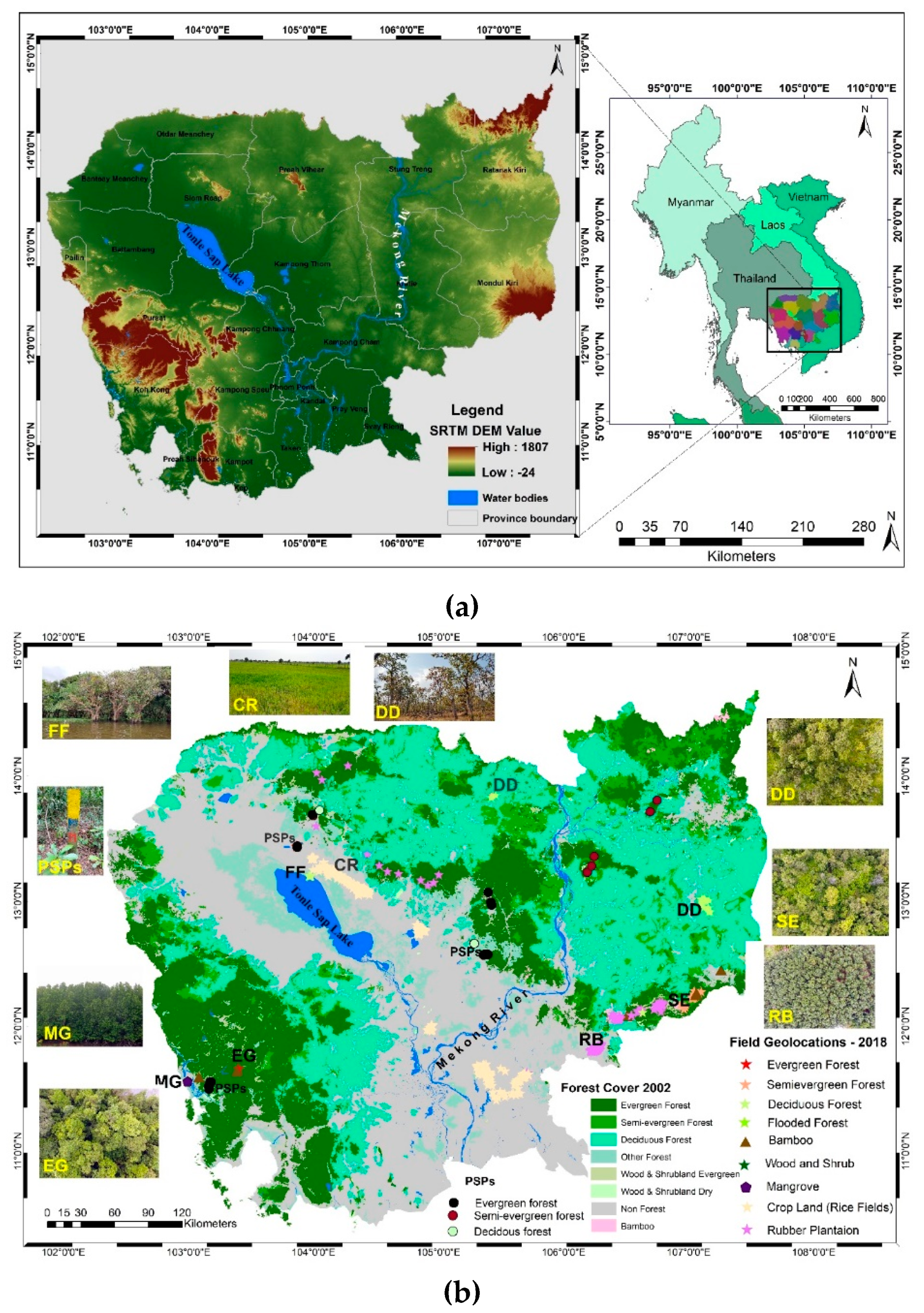
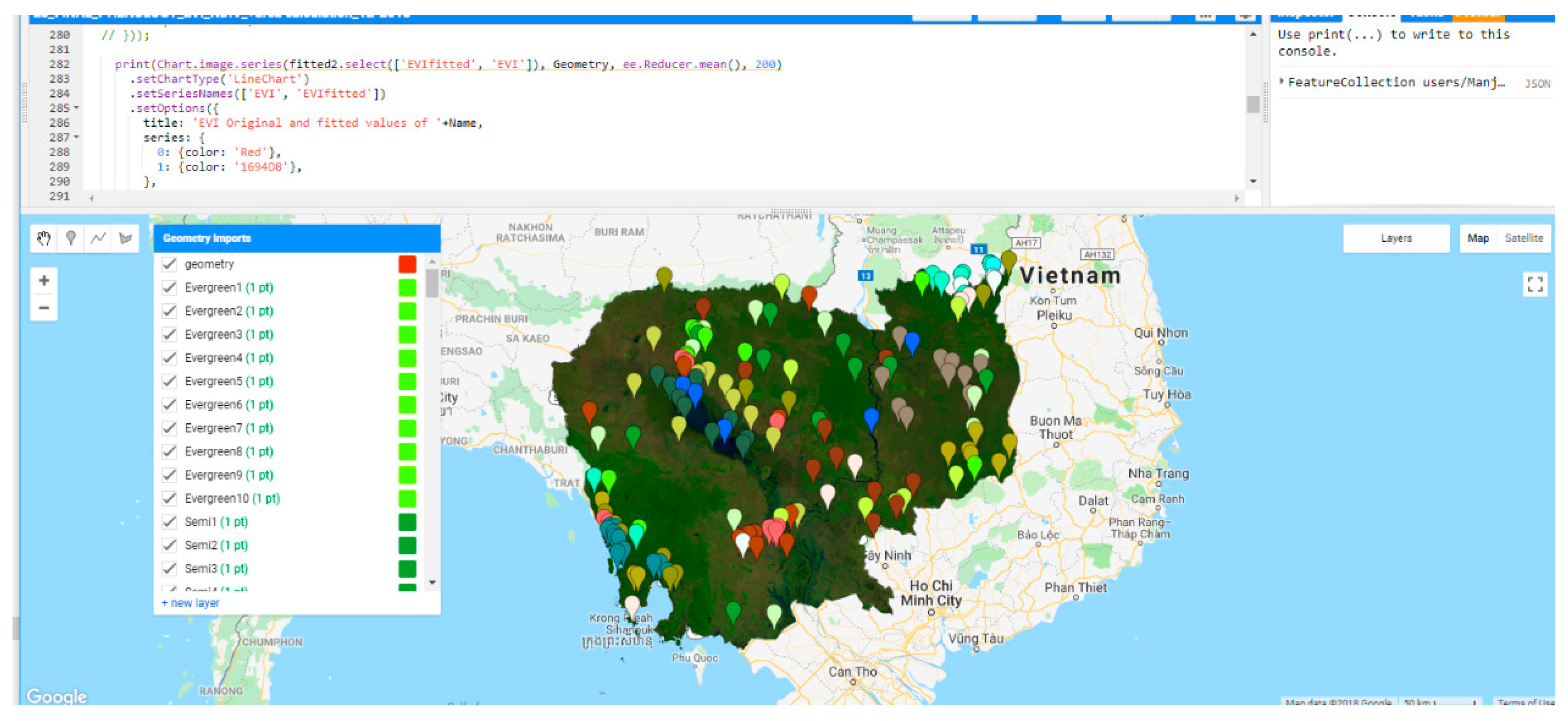
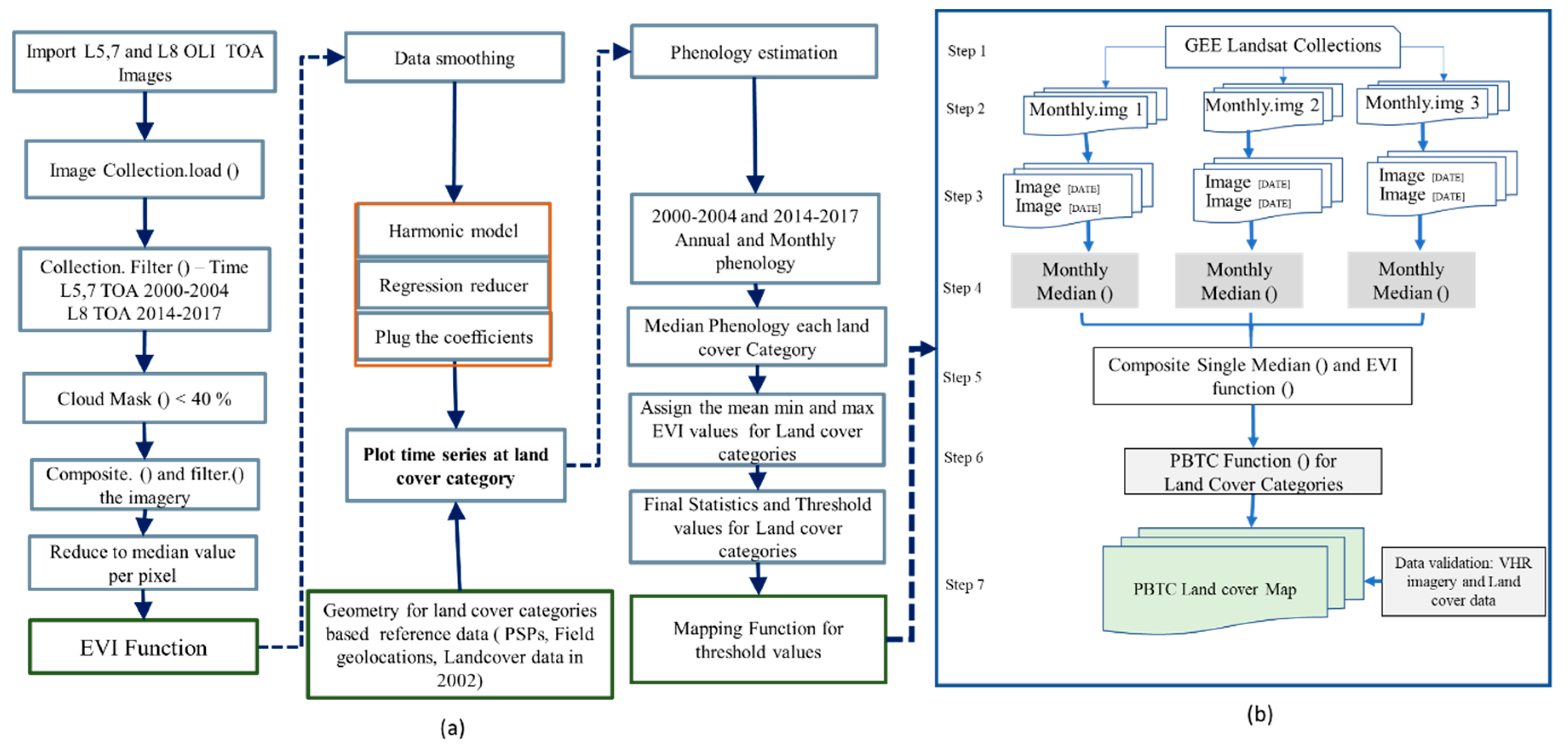


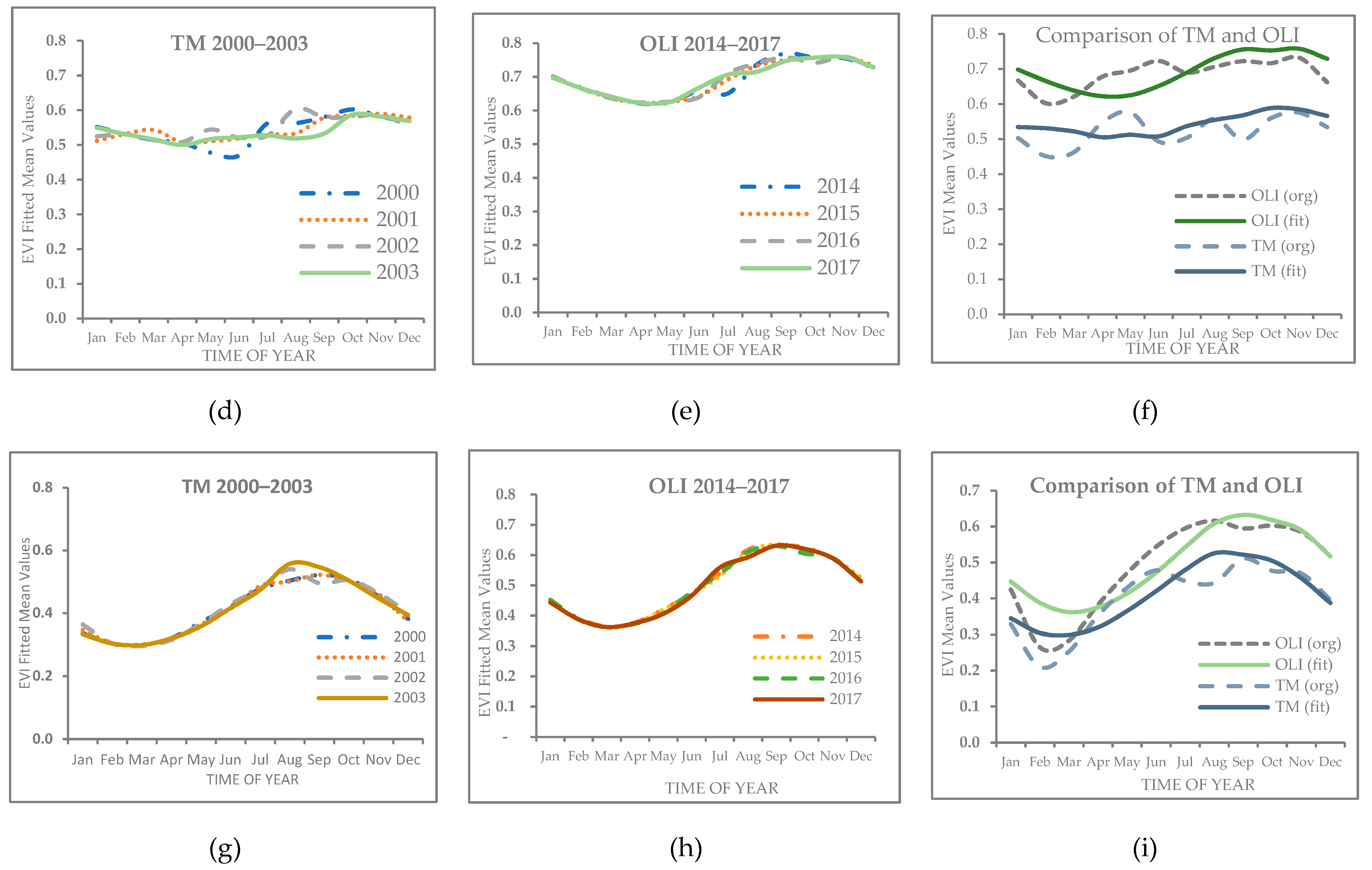
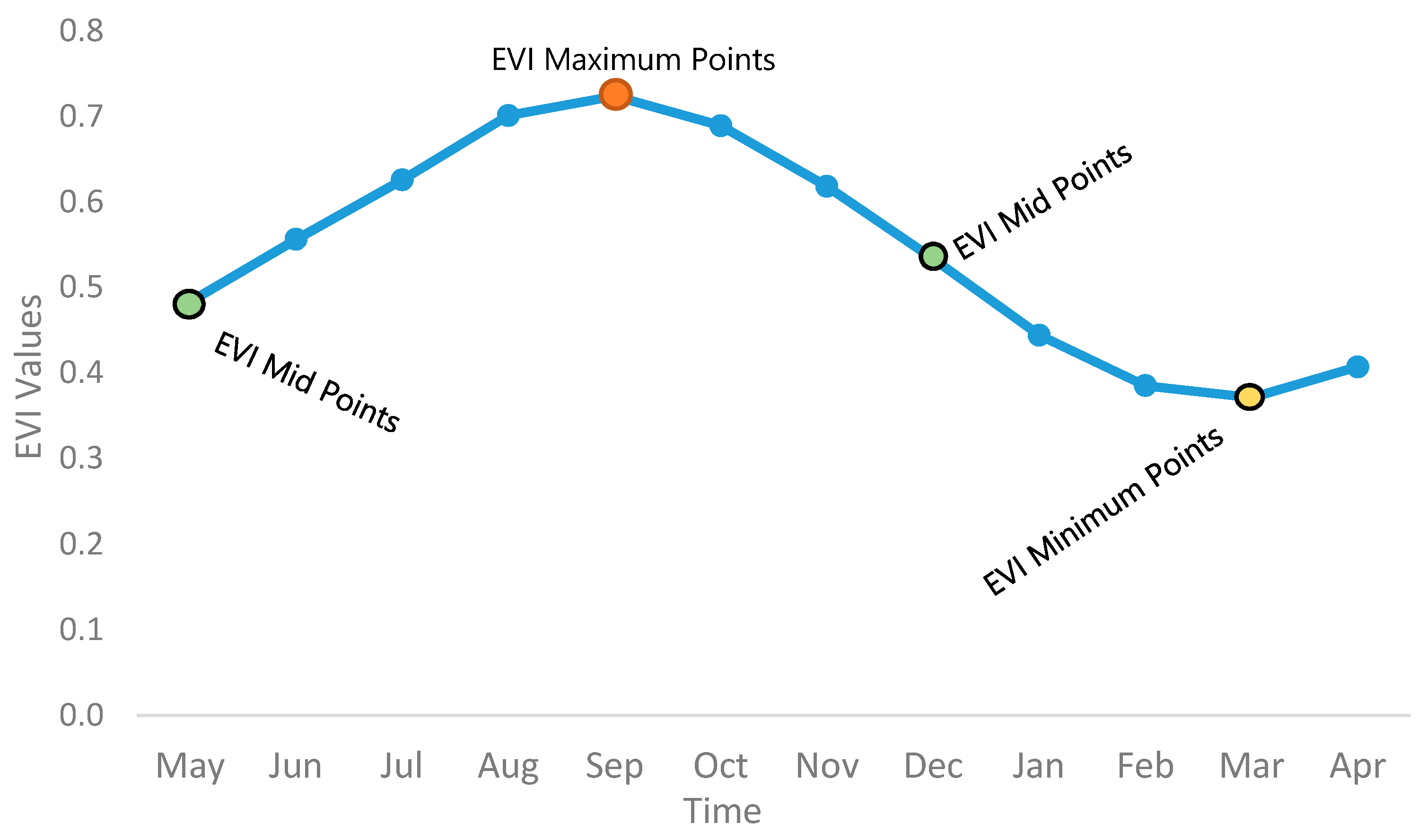
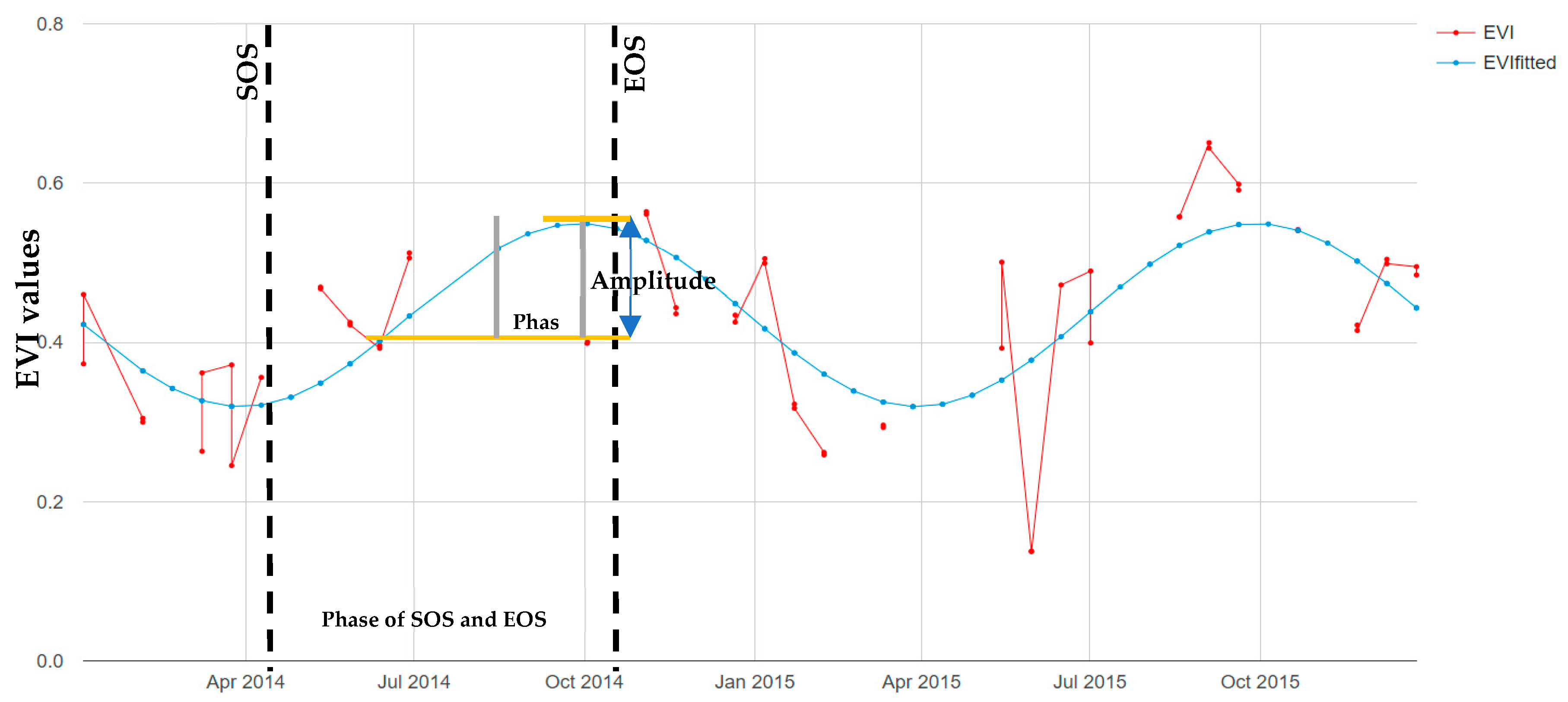
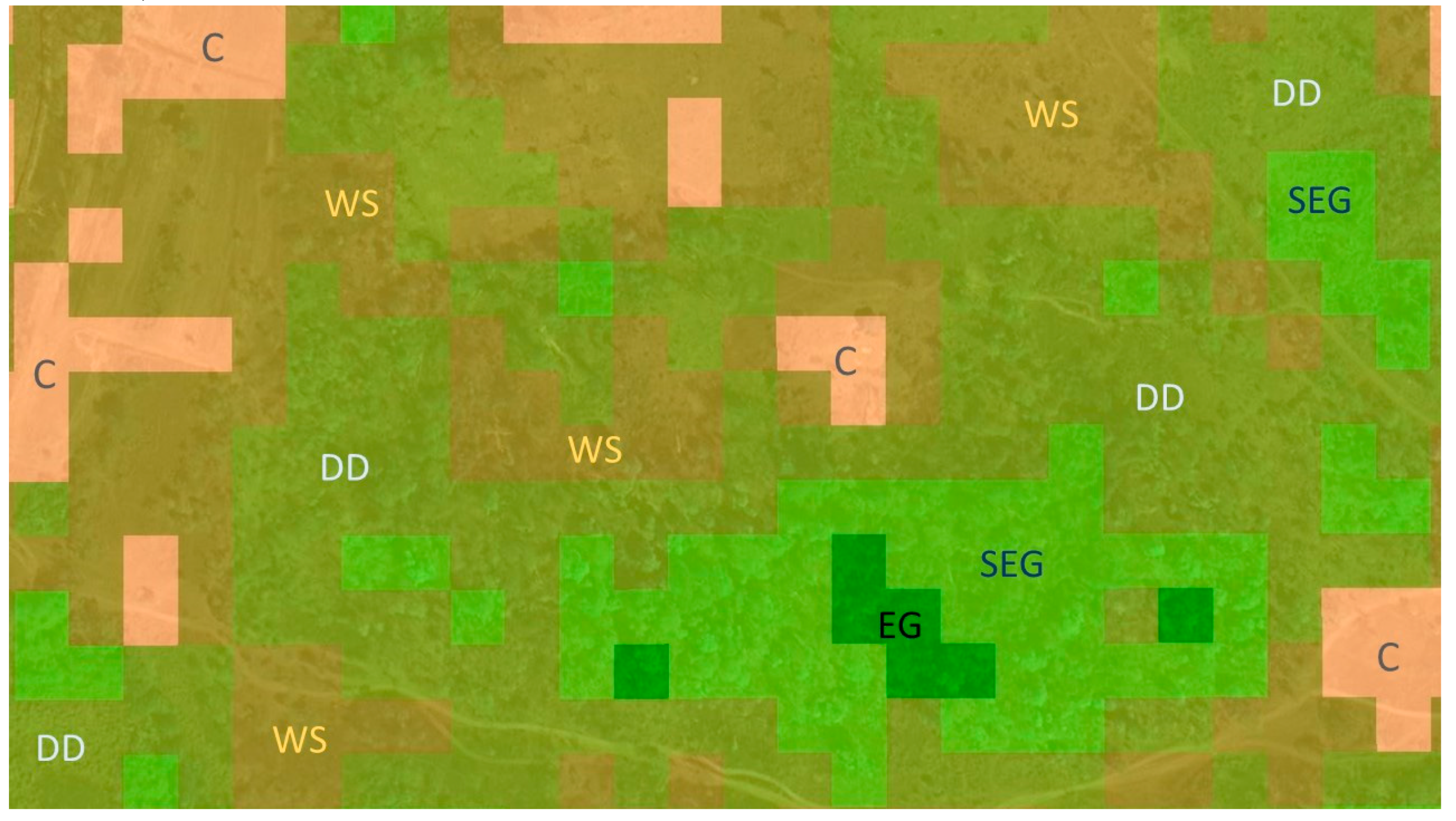
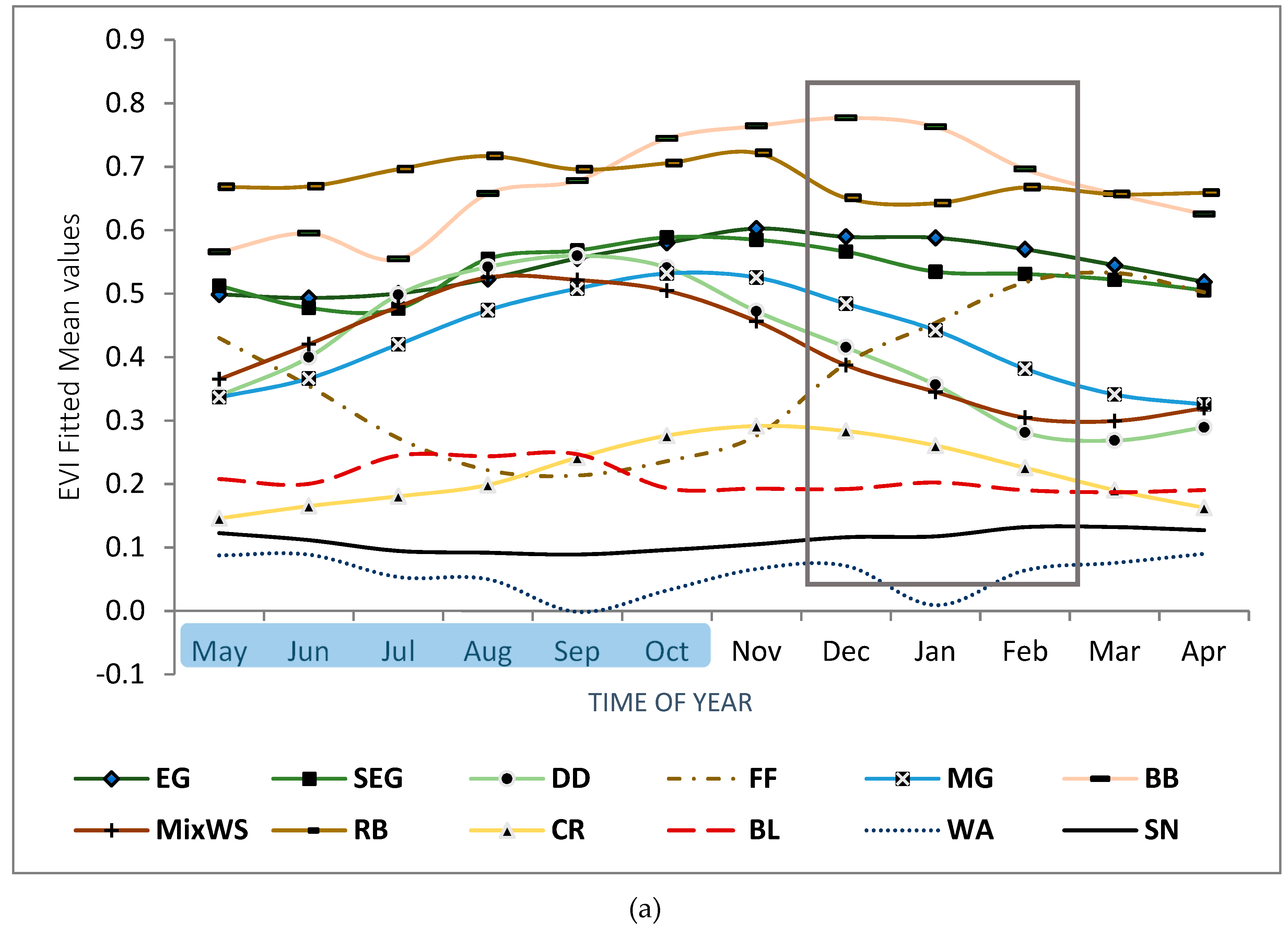
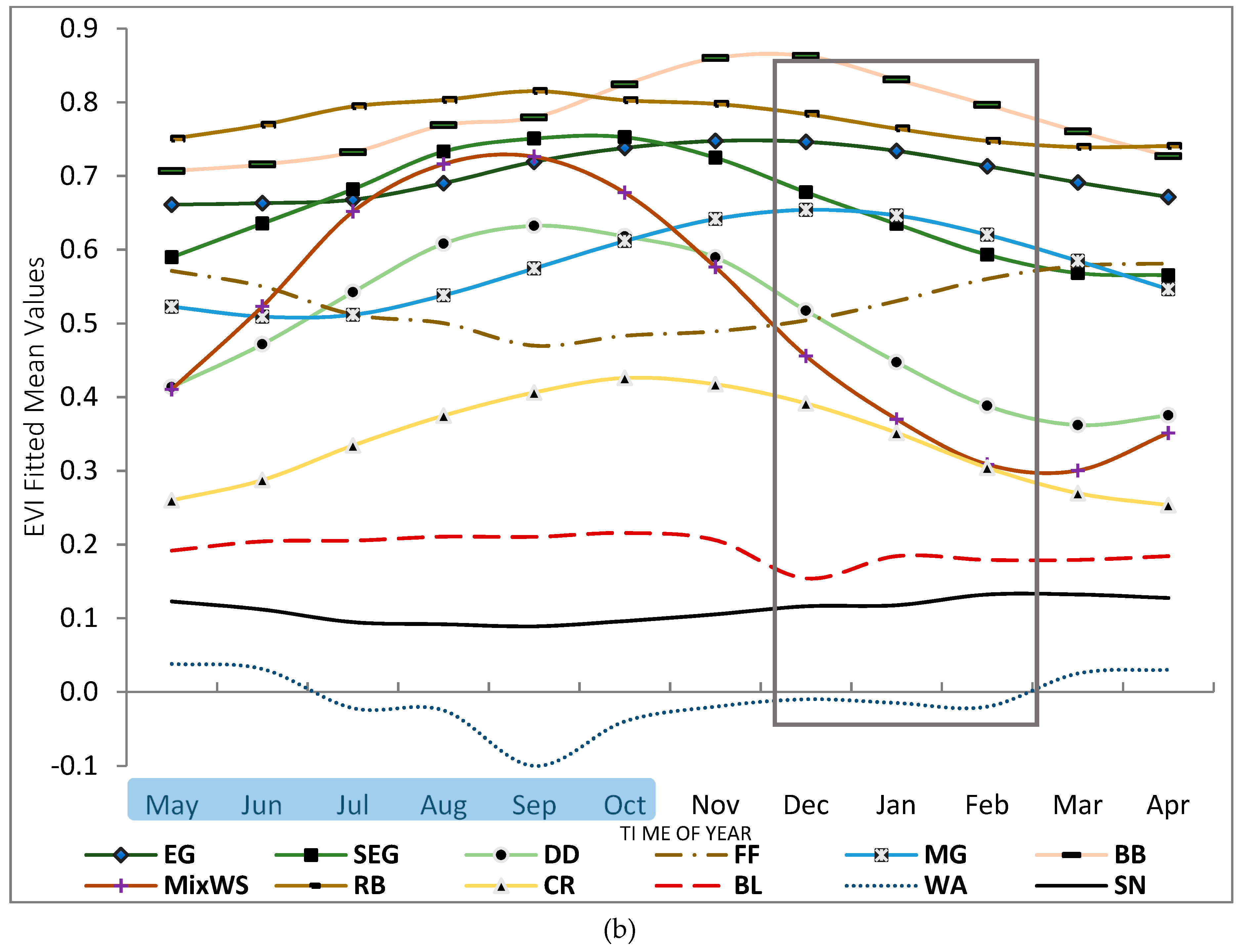
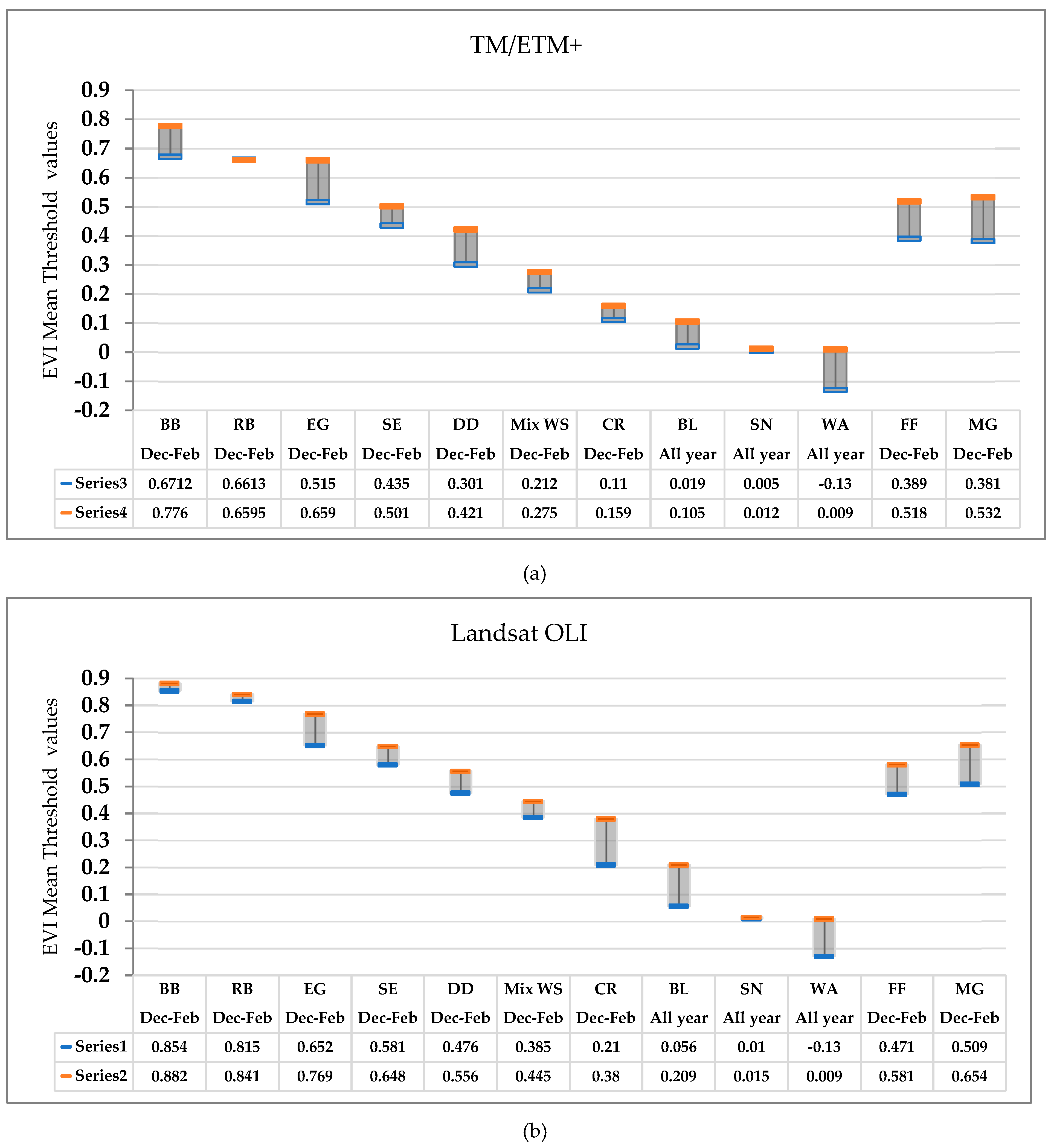
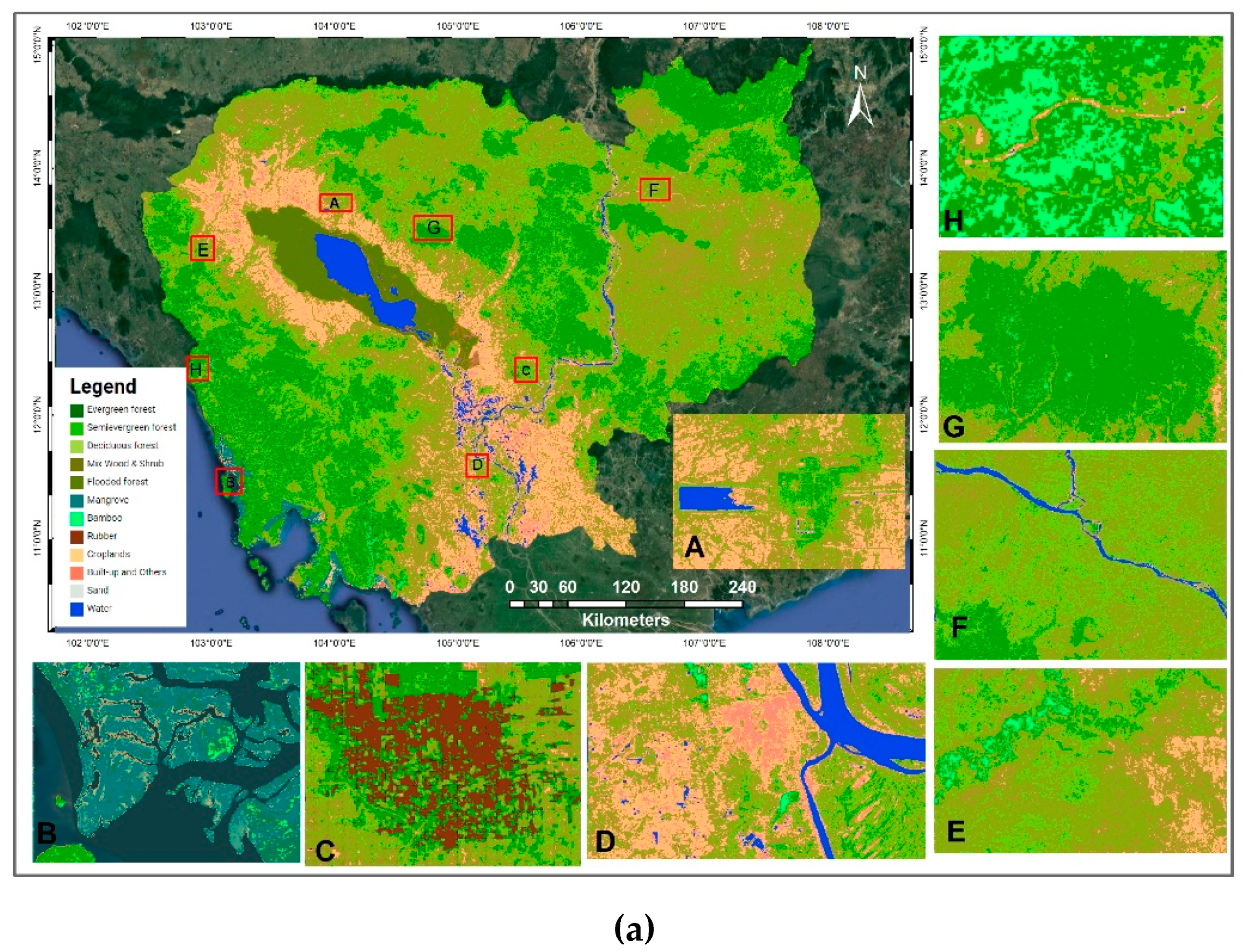
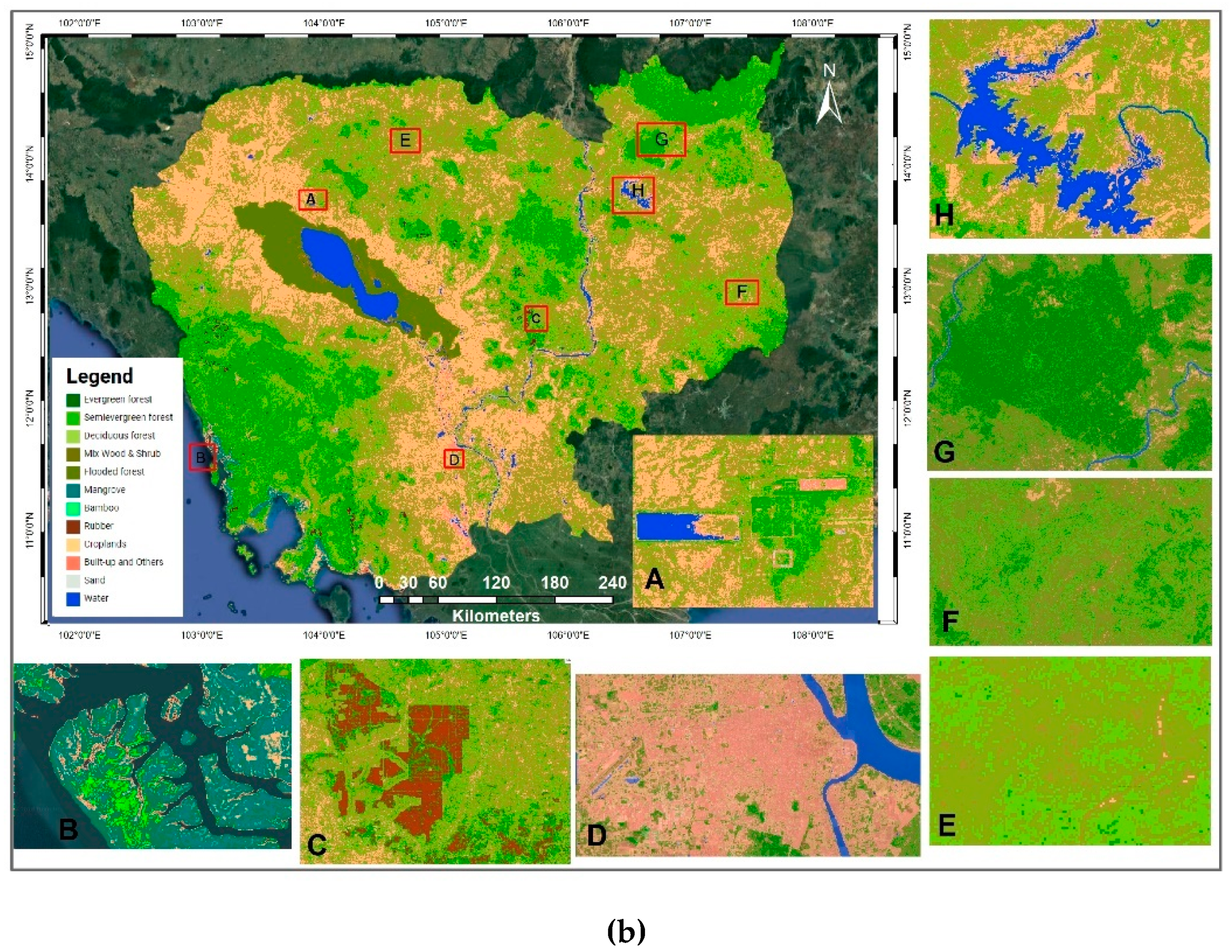
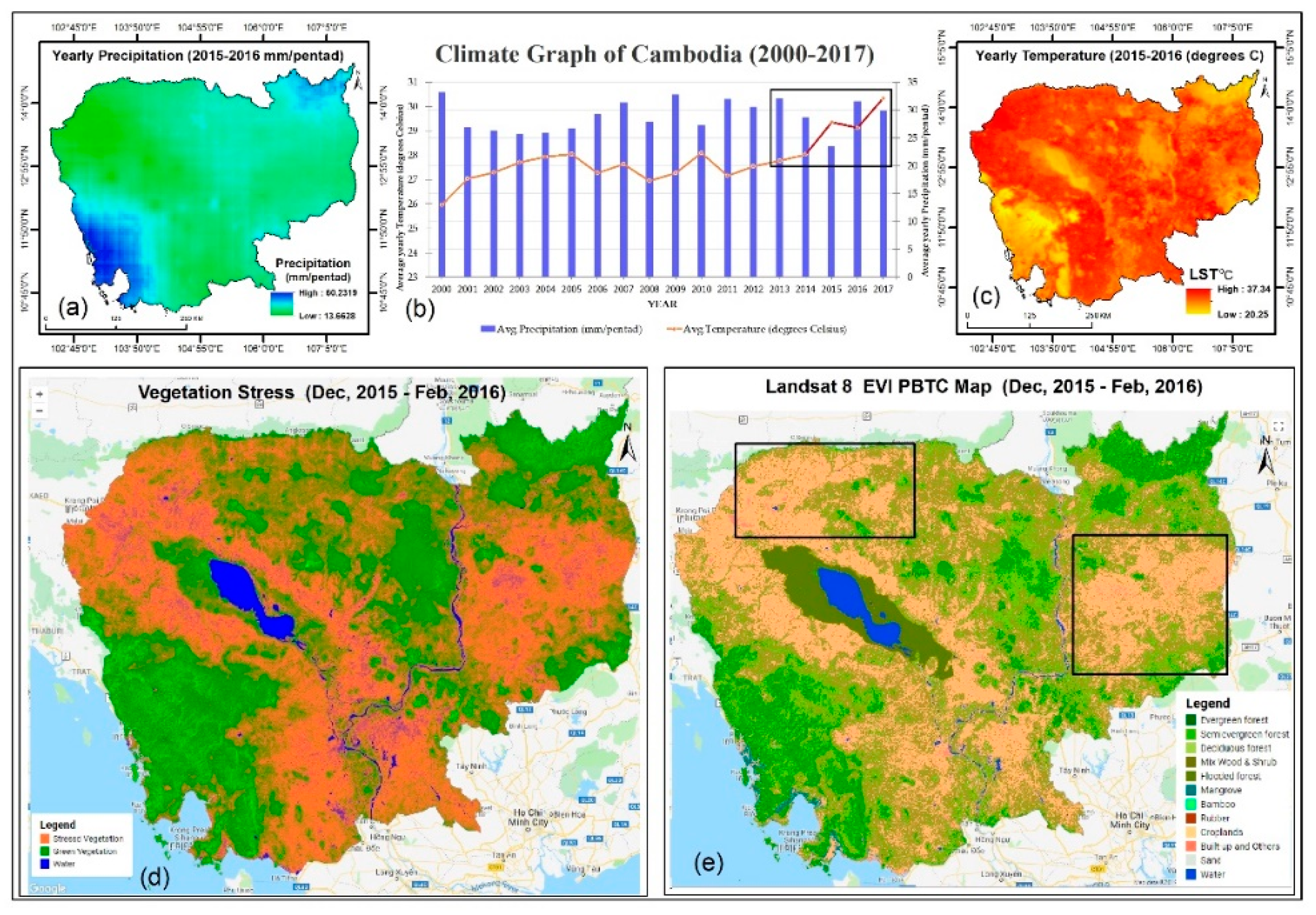
| No. | Land Cover Categories Used in This Study | Acronyms/ID | Description |
|---|---|---|---|
| 1 | Evergreen forest | EG | Forests where more than 80% of tree species maintain their leaves throughout the year. |
| 2 | Semievergreen forest | SEG | Forests containing a mixture of evergreen and deciduous tree species. |
| 3 | Deciduous forest | DD | Forests where more than 80% of tree species are deciduous, shedding their leaves during the dry season of the year. |
| 4 | Mix wood and shrub | MixWS | This category consists of a mixture of evergreen and deciduous short tree species and is predominantly covered by shrubs or crops |
| 5 | Flooded forest | FF | These forests are permanently underwater, except in the dry season. They are mainly distributed in Tonle Sap Lake and along the riverbanks. |
| 6 | Mangrove forest | MG | These forests are located along the coastal areas of Cambodia, where mangrove species are dominant. |
| 7 | Bamboo | BB | This is a land category dominated by bamboo |
| 8 | Rubber plantation | RB | This category refers to rubber plantations |
| 9 | Croplands | CR | This category includes arable land, tillage land, and paddy fields |
| 10 | Built-up area | BL | This category includes building and construction areas |
| 11 | Sand | SN | This category includes sandy land |
| 12 | Water | WA | Areas with fresh and sea water |
| Land Cover Categories | Original Mean EVI Profiles of TM/ETM+ and OLI | Fitted Mean EVI Profiles of TM/ETM+ and OLI | Average Yearly Original EVI Profiles | Average Yearly Fitted EVI Profiles | Fitted Mean Profiles (SOS–EOS) | Fitted Mean Profiles (LFP–LSP) | Final Mean LSP Profiles | |||||||
|---|---|---|---|---|---|---|---|---|---|---|---|---|---|---|
| 2000–2003 | 2014–2017 | 2000–2003 | 2014–2017 | TM/ETM+ | OLI | TM/ETM+ | OLI | TM/ETM+ | OLI | TM/ETM+ | OLI | TM/ETM+ | OLI | |
| EG | 10 | 10 | 10 | 10 | 4 | 4 | 4 | 4 | 1 | 1 | 1 | 1 | 1 | 1 |
| SEG | 10 | 10 | 10 | 10 | 4 | 4 | 4 | 4 | 1 | 1 | 1 | 1 | ||
| DD | 10 | 10 | 10 | 10 | 4 | 4 | 4 | 4 | 1 | 1 | 1 | 1 | ||
| WS | 10 | 10 | 10 | 10 | 4 | 4 | 4 | 4 | 1 | 1 | 1 | 1 | ||
| FF | 10 | 10 | 10 | 10 | 4 | 4 | 4 | 4 | 1 | 1 | 1 | 1 | ||
| MGR | 10 | 10 | 10 | 10 | 4 | 4 | 4 | 4 | 1 | 1 | 1 | 1 | ||
| BMB | 10 | 10 | 10 | 10 | 4 | 4 | 4 | 4 | 1 | 1 | 1 | 1 | ||
| RBR | 10 | 10 | 10 | 10 | 4 | 4 | 4 | 4 | 1 | 1 | 1 | 1 | ||
| CR | 10 | 10 | 10 | 10 | 4 | 4 | 4 | 4 | 1 | 1 | 1 | 1 | ||
| BL | 10 | 10 | 10 | 10 | 4 | 4 | 4 | 4 | 1 | 1 | 1 | 1 | ||
| SN | 10 | 10 | 10 | 10 | 4 | 4 | 4 | 4 | 1 | 1 | 1 | 1 | ||
| WA | 10 | 10 | 10 | 10 | 4 | 4 | 4 | 4 | 1 | 1 | 1 | 1 | ||
| Total | 120 | 120 | 120 | 120 | 48 | 48 | 48 | 48 | 12 | 12 | 12 | 12 | 1 | 1 |
| (a) 2018 Assessment GIS VHR Reference Categories | |||||||||||||
| 2018 Classified Categories | EG | SEG | DD | Mix WS | FF | MG | BB | RB | CR | BL | SN | WA | User’s Accuracy |
| EG | 50 | 2 | 2 | 2 | 1 | 2 | 84.7% | ||||||
| SEG | 3 | 31 | 1 | 1 | 2 | 1 | 1 | 77.5% | |||||
| DD | 58 | 2 | 1 | 95.1% | |||||||||
| Mix WS | 1 | 2 | 41 | 1 | 1 | 89.1% | |||||||
| FF | 10 | 1 | 90.9% | ||||||||||
| MG | 1 | 20 | 95.2% | ||||||||||
| BB | 1 | 25 | 1 | 92.6% | |||||||||
| RB | 2 | 14 | 87.5% | ||||||||||
| CR | 1 | 2 | 54 | 1 | 93.1% | ||||||||
| BL | 1 | 4 | 80.0% | ||||||||||
| SN | 1 | 100% | |||||||||||
| WA | 10 | 100% | |||||||||||
| Producer’s accuracy | 92.6% | 91.2% | 93.5% | 89.1% | 62.5% | 83.3% | 89.3% | 77.8% | 94.7% | 80.0% | 100% | 100% | Overall Accuracy 89.58% |
| Kappa 0.88 Total reference points 355 | |||||||||||||
| (b) 2000 Assessment Google Earth VHR Reference Categories | |||||||||||||
| 2000 Classified Categories | EG | SEG | DD | Mix WS | FF | MG | BB | RB | CR | BL | SN | WA | User’s Accuracy |
| EG | 47 | 2 | 2 | 1 | 2 | 2 | 83.9% | ||||||
| SEG | 2 | 46 | 1 | 2 | 1 | 1 | 2 | 83.6% | |||||
| DD | 1 | 78 | 1 | 1 | 1 | 95.1% | |||||||
| Mix WS | 1 | 1 | 3 | 35 | 2 | 83.3% | |||||||
| FF | 11 | 2 | 84.6% | ||||||||||
| MG | 1 | 8 | 88.9% | ||||||||||
| BB | 2 | 1 | 29 | 2 | 85.3% | ||||||||
| RB | 2 | 14 | 87.5% | ||||||||||
| CR | 2 | 19 | 90.5% | ||||||||||
| BL | 1 | 6 | 85.7% | ||||||||||
| SN | 1 | 3 | 75.0% | ||||||||||
| WA | 16 | 100% | |||||||||||
| Producer’s accuracy | 90.4% | 90.2% | 95.1% | 92.1% | 64.7% | 66.7% | 85.3% | 70.0% | 82.6% | 85.7% | 100% | 100% | Overall Accuracy 87.89% |
| Kappa 0.86 Total reference points 355 | |||||||||||||
| (a) 2018 Assessment Forest Cover Reference Categories | ||||||||
| 2018 Classified Categories | EG | SEG | DD | OF | Mix WS | NF | BB | User’s accuracy |
| EG | 45 | 1 | 1 | 1 | 1 | 91.8% | ||
| SEG | 28 | 2 | 93.3% | |||||
| DD | 2 | 57 | 2 | 1 | 91.9% | |||
| OF | 8 | 3 | 5 | 46 | 3 | 4 | 66.7% | |
| Mix WS | 3 | 36 | 3 | 85.7% | ||||
| NF | 1 | 3 | 70 | 94.6% | ||||
| BB | 1 | 28 | 96.6% | |||||
| Producer’s accuracy | 84.9% | 82.4% | 83.8% | 95.8% | 80.0% | 89.7% | 96.6% | Overall Accuracy 87.32% |
| Kappa 0.85 | ||||||||
| (b) 2000 Assessment Forest Cover Reference Categories | ||||||||
| 2000 Classified Categories | EG | SEG | DD | OF | Mix WS | NF | BMB | User’s accuracy |
| EG | 42 | 9 | 2 | 79.2% | ||||
| SEG | 8 | 39 | 2 | 1 | 78.0% | |||
| DD | 1 | 72 | 2 | 96.0% | ||||
| OF | 2 | 4 | 9 | 25 | 3 | 1 | 2 | 54.3% |
| Mix WS | 1 | 32 | 2 | 91.4% | ||||
| NF | 1 | 1 | 1 | 1 | 61 | 4 | 88.4% | |
| BMB | 2 | 25 | 92.6% | |||||
| Producer’s accuracy | 79.2% | 72.2% | 84.7% | 100.0% | 78.0% | 92.4% | 80.6% | Overall Accuracy 83.38% |
| Kappa 0.80 | ||||||||
© 2019 by the authors. Licensee MDPI, Basel, Switzerland. This article is an open access article distributed under the terms and conditions of the Creative Commons Attribution (CC BY) license (http://creativecommons.org/licenses/by/4.0/).
Share and Cite
Venkatappa, M.; Sasaki, N.; Shrestha, R.P.; Tripathi, N.K.; Ma, H.-O. Determination of Vegetation Thresholds for Assessing Land Use and Land Use Changes in Cambodia using the Google Earth Engine Cloud-Computing Platform. Remote Sens. 2019, 11, 1514. https://doi.org/10.3390/rs11131514
Venkatappa M, Sasaki N, Shrestha RP, Tripathi NK, Ma H-O. Determination of Vegetation Thresholds for Assessing Land Use and Land Use Changes in Cambodia using the Google Earth Engine Cloud-Computing Platform. Remote Sensing. 2019; 11(13):1514. https://doi.org/10.3390/rs11131514
Chicago/Turabian StyleVenkatappa, Manjunatha, Nophea Sasaki, Rajendra Prasad Shrestha, Nitin Kumar Tripathi, and Hwan-Ok Ma. 2019. "Determination of Vegetation Thresholds for Assessing Land Use and Land Use Changes in Cambodia using the Google Earth Engine Cloud-Computing Platform" Remote Sensing 11, no. 13: 1514. https://doi.org/10.3390/rs11131514
APA StyleVenkatappa, M., Sasaki, N., Shrestha, R. P., Tripathi, N. K., & Ma, H.-O. (2019). Determination of Vegetation Thresholds for Assessing Land Use and Land Use Changes in Cambodia using the Google Earth Engine Cloud-Computing Platform. Remote Sensing, 11(13), 1514. https://doi.org/10.3390/rs11131514







